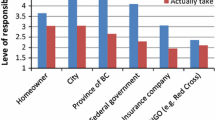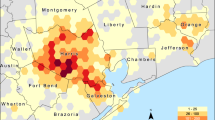Abstract
We describe factors related to the social vulnerability of populations that experienced major river flooding in northern New South Wales (NSW), Australia. Using geographical information system methods, maps of 2017 flood-affected areas in the Lismore and Murwillumbah regions were combined with 2016 National census data to compare aspects of social vulnerability with the wider region and the region with Sydney. We also used individual-level data from the NSW 45 and Up Study to compare lifestyle, behavioural and health characteristics of residents of these flood-affected areas with the broader region (n = 13,561). Populations living in the Lismore Town Centre flood footprint exhibited significantly higher levels of social vulnerability over a range of factors; in particular, almost 82% resided in the most disadvantaged socio-economic quintile neighbourhoods. The flood-affected areas of Murwillumbah and Lismore regions included 47% and 60% of residents in the most disadvantaged quintile neighbourhoods compared to 27% for whole region and 16% for Sydney. This pattern of increased vulnerability was also apparent from the 45 and Up study; participants residing in the Lismore Town Centre flood footprint had significantly higher rates of riskier lifestyle-related behaviours (smoking, alcohol consumption), pre-existing mental health conditions (depression and anxiety) and poorer health. This detailed case study demonstrates extreme local vulnerability of flood-exposed populations, over and above the already highly vulnerable regional rural populations. This information is important to inform disaster planning and response and also reinforces the importance of having a detailed understanding of affected populations.

Similar content being viewed by others
References
Alderman K, Turner L, Tong S (2012) Floods and human health: a systematic review. Environ Int 47(2012):37–47
Australian Bureau of Statistics (2012) Information paper: use of the kessler psychological distress scale in ABS health surveys, Australia, 2007–08. ABS cat. no. 4817.0.55.001. Canberra: ABS
Australian Bureau of Statistics (2013) Census of population and housing: socio-economic indexes for areas (SEIFA). ABS, Canberra 2013. http://www.abs.gov.au/ausstats/abs@.nsf/Lookup/2033.0.55.001main+features100132011. Accessed Jan 2018
Australian Bureau of Statistics (2016a) 2074.0: census of population and housing: mesh block counts, Australia. ABS data 2074.0. http://www.abs.gov.au/ausstats/abs@.nsf/0/B58F9B40B7D4B4CDCA257AD0000F1EF0. Accessed June 2017
Australian Bureau of Statistics (2016b) Australian Statistical Geography Standard (ASGS): volume 1—main structure and greater capital city statistical areas. ABS technical paper 1270.0.55.001. http://www.abs.gov.au/ausstats/abs@.nsf/Lookup/by%20Subject/1270.0.55.001~July%202016~Main%20Features~Classification%20structures~10006. Accessed June 2017
Australian Bureau of Statistics (2016c) Australian Statistical Geography Standard (ASGS). http://www.abs.gov.au/websitedbs/D3310114.nsf/home/Australian+Statistical+Geography+Standard+(ASGS). Accessed 25 June 2017
Australian Bureau of Statistics (2018a) 2016 census overview. http://www.abs.gov.au/websitedbs/D3310114.nsf/Home/Assuring%20Census%20Data%20Quality. Accessed 21 Apr 2018
Australian Bureau of Statistics (2018b) Community profiles. http://www.abs.gov.au/websitedbs/D3310114.nsf/Home/2016%20Census%20Community%20Profiles. Accessed 21 Apr 2018
Australian Bureau of Statistics (2018c) 2916.0: census of population and housing—QuickStats, community profiles and DataPacks user guide, Australia, 2016. http://www.abs.gov.au/ausstats/abs@.nsf/Latestproducts/2916.0Main%20Features202016?opendocument&tabname=Summary&prodno=2916.0&issue=2016&num=&view=. Accessed 26 Apr 2018
Australian Bureau of Statistics (2018d) Socio-economic indices for areas (2016). ABS technical paper: 2033.0.55.001. http://www.abs.gov.au/AUSSTATS/abs@.nsf/DetailsPage/2033.0.55.0012016?OpenDocument. Accessed Mar 2018
Australian Business Roundtable for Disaster Resilience & Safer Communities (ABRDRSC) (2015) The economic cost of the social impact of natural disasters. 2015 deloitte access economics. https://www.iag.com.au/sites/default/files/Documents/Announcements/ABR_Report-Economic-cost-social-impact-natural-disasters-020316.pdf. Accessed 21 Apr 2018
Banks E et al (2008) Cohort profile: the 45 and up study. Int J Epidemiol 37:941–947
Bei B, Bryant C, Gilson KM, Koh J, Gibson P, Komiti A, Jackson H, Judd F (2013) A prospective study of the impact of floods on the mental and physical health of older adults. Aging Ment Health 17(8):992–1002
Berry HL, Waite TD, Dear KB, Capon AG, Murray V (2018) The case for systems thinking about climate change and mental health. Nat Clim Change 8(4):282
Bin O, Polasky S (2004) Effects of flood hazards on property values; evidence before and after hurricane floyd. Land Econ 80(4):490–500
Boon J (2014) Disaster resilience in a flood-impacted rural Australian town. Nat Hazards 71:683–701
Buckle P, Mars G, Smale S (2000) New approaches to assessing vulnerability and resilience. Aust J Emerg Manag 15(2):8
Dakin SK (2017) NSW north coast flood summary March 2017. NSW report MHL2535. Office of Environment and Heritage: Manly Vale. http://new.mhl.nsw.gov.au/docs/floodreport/2017/mhl2535_NorthCoastFloodSummaryMarch2017_FINAL.pdf. Accessed 6 Aug 2018
Fatemi F, Ardalan A, Aguirre B, Mansouri N, Iraj M (2017) Social vulnerability indicators in disasters; findings from a systematic review. Int J Disaster Risk Reduct 22(2017):219–227
Fekete A (2010) Assessment of social vulnerability for river-floods in Germany dissertation. United Nations University—Institute for Environment and Human Security Bonn, Germany. https://d-nb.info/1001191064/34. Accessed 10 Sept 2019
Fekete A (2012) Spatial disaster vulnerability and risk assessments: challenges in their quality and acceptance. Nat Hazards 61:1161–1178
Fielding JL (2018) Flood risk and inequalities between ethnic groups in the floodplains of England and Wales. Disasters 42(1):101–123
Gergis J (2017) Northern NSW is no stranger to floods, but this one was different. The Conversation. https://theconversation.com/northern-nsw-is-no-stranger-to-floods-but-this-one-was-different-75701. Accessed 06 Aug 2018
Gubhaju L, McNamara BJ, Banks E, Joshy G, Raphael B, Williamson A, Eades S (2013) The overall health and risk factor profile of Australian Aboriginal and Torres Strait Islander participants from the 45 and up study. BMC Public Health 17(13):661. https://doi.org/10.1186/1471-2458-13-661
Hirsch J, Hahn J (2018) How flood risk impacts residential rents and property prices: empirical analysis of a German property market. J Prop Invest Finance 36(1):50–67
Hu P, Zhang Q, Shi P, Chen B (2018) Flood-induced mortality across the globe: spatiotemporal pattern and influencing factors. Sci Total Environ 643(2018):171–182
Khalili S, Harre M, Morley P (2015) A temporal framework of social resilience indicators of communities to flood, case studies: Wagga Wagga and Kempsey, NSW, Australia. Int J Disaster Risk Reduct 13:248–254
King D (2001) Uses and limitations of socioeconomic indicators of community vulnerability to natural hazards: data and disasters in Northern Australia. Nat Hazards 24(2):147–156
Kleinosky L, Yarnal B, Fisher A (2007) Vulnerability of Hampton Roads, Virginia to storm-surge flooding and sea-level rise. Nat Hazards 40:43–70
Kuhlicke C, Scolobig A, Steinfuhrer A, De Marchi B (2011) Contextualizing social vulnerability; findings from case studies across Europe. Nat Hazards 58:789–810
Lee Y-J (2014) Social vulnerability indicators as a sustainable planning tool. Environ Impact Assess Rev 44(2014):31–42
Milojevic A, Armstrong B, Wilkinson P (2017) Mental health impacts of flooding: a controlled interrupted time series analysis of prescribing data in England. J Epidemiol Commun Health 71(10):970–973
Office of Environment and Heritage (OEH) (n.d.) (2014) North Coast Rainfall 2020–2039. http://climatechange.environment.nsw.gov.au/Climate-projections-for-NSW/Climate-projections-for-your-region/North-Coast-Climate-Change-Download. Accessed 12 Apr 2018
Queensland Government. Statistician’s Office (2018) Estimated resident population by statistical area level 1 (SA1), Australia, 2011 to 2017p (ABS consultancy). http://www.qgso.qld.gov.au/products/tables/erp-sa1-aus-consult/index.php?region=northern. Accessed 26 July 2018
Remo J, Pinter N, Mahgoub M (2016) Assessing Illinois’s vulnerability using Hazus-MH. Nat Hazards 81:265–287
Rufat S, Tate E, Burton CG, Maroof AS (2015) Social vulnerability to floods: review of case studies and implications for measurement. Int J Disaster Risk Reduct 14:470–486
Sewell T, Stephens R, Dominey-Howes D, Bruce E, Perkins-Kirkpatrick S (2016) Disaster declarations associated with bushfires, floods and storms in New South Wales, Australia between 2004 and 2014. Sci Rep 6:1–11. https://doi.org/10.1038/srep36369
Simpson D, Human R (2008) Large-scale vulnerability assessments for natural hazards. Nat Hazards 47:143–155
Social Policy Research Centre (2016) Poverty in Australia 5th edition downloaded from https://www.acoss.org.au/wp-content/uploads/2016/10/Poverty-in-Australia-2016.pdf. Accessed Oct 2018
Stanke C, Murray V, Amlot R, Nurse J, Williams R (2012) The effects of flooding on mental health; outcomes and recommendations from a review of the literature. PLoS Curr. https://doi.org/10.1371/4f9f1fa9c3cae
Tsumori K, Saunders P, Hughes H (2002) Poor arguments: a response to the Smith Family report on poverty in Australia. Issue Analysis. Centre for Independent Studies, Sydney
United Nations Office for Disaster Risk Reduction (UNISDR) (2015a) Making development sustainable: the future of disaster risk management. Global assessment report on disaster risk reduction. United Nations Office for Disaster Risk Reduction (UNISDR), Geneva, Switzerland. ISBN/ISSN: 9789211320428. https://www.unisdr.org/we/inform/publications/42809. Accessed 10 Sept 2019
United Nations Office for Disaster Risk Reduction (UNISDR) (2015b) Sendai framework for disaster risk reduction 2015–2030. 2015, UNISDR Geneva. https://www.unisdr.org/we/inform/publications/43291. Accessed 10 Sept 2019
Walker G, Burningham K (2011) Flood risk, vulnerability and environmental justice: evidence and evaluation of inequality in a UK context. Crit Soc Policy 31(2):216–240
Zhong S, Yang L, Toloo S, Wang Z et al (2018) The long-term physical and psychological health impacts of flooding; a systematic mapping. Sci Total Environ 626(2018):165–194
Acknowledgements
The Office of Environment and Heritage for the provision of the 2017 Flood maps in GIS ready format and for detailed advice about their construction based on consultants’ BMT WBM Pty Ltd reports. Post Event Flood Behaviour Analysis and Review of Flood Intelligence—Lismore Final Report Reference: R.B22696.001.02_Lismore.docx (April 2018) and Post Event Flood Behaviour Analysis and Review of Flood Intelligence—Tweed River Draft Final Report (Reference: R.B22696.001.01_Tweed.docx January 2018). Further details of these reports available from the OEH Conservation and Regional Delivery Division, Office of Environment and Heritage, PO Box 856 Alstonville NSW 2477. Lismore City Council for the provision of early 2017 flood maps and the 1974 flood map in GIS ready format and for detailed knowledge on the history of flooding in the town. Tweed Shire Council for Design Flood Maps and for advice on the extent of the 2017 Murwillumbah flood with respect to its extent and comparison to the Design Flood Levels (1 in 100-year flood). This research was completed using data collected through the 45 and Up Study (www.saxinstitute.org.au). The 45 and Up Study is managed by the Sax Institute in collaboration with major partner Cancer Council NSW and partners: the National Heart Foundation of Australia (NSW Division); NSW Ministry of Health; NSW Government Family and Community Services—Ageing, Carers and the Disability Council NSW; and the Australian Red Cross Blood Service. We thank the many thousands of people participating in the 45 and Up Study. The 45 and Up Study was approved by the University of New South Wales Human Research Ethics Committee (HREC). Informed consent was obtained from all survey participants. The 45 and Up Study component of this paper was approved by the NSW Population and Health Services Research Ethics Committee AU RED Reference: HREC/15/CIPHS/4, Cancer Institute NSW reference number: 2015/02/575 for Sub-study 2 [Air Pollution, Traffic Exposures and Mortality and Morbidity in Older Australians (APTEMA) Study], under the overarching project titled ‘Understanding the impact of the social, economic and environmental factors on the health of Australians in mid-later life; where are the opportunities for prevention?’ (NHMRC Grant 402810). Dr Ivan Hanigan for his contribution to the linking of geocoded participant residential address identifiers and the flood footprint maps within the SURE environment of the SAX Institute.
Funding
None received.
Author information
Authors and Affiliations
Corresponding author
Ethics declarations
Conflict of interest
The authors declare that they have no conflict of interest.
Additional information
Publisher's Note
Springer Nature remains neutral with regard to jurisdictional claims in published maps and institutional affiliations.
Electronic supplementary material
Below is the link to the electronic supplementary material.
Rights and permissions
About this article
Cite this article
Rolfe, M.I., Pit, S.W., McKenzie, J.W. et al. Social vulnerability in a high-risk flood-affected rural region of NSW, Australia. Nat Hazards 101, 631–650 (2020). https://doi.org/10.1007/s11069-020-03887-z
Received:
Accepted:
Published:
Issue Date:
DOI: https://doi.org/10.1007/s11069-020-03887-z




